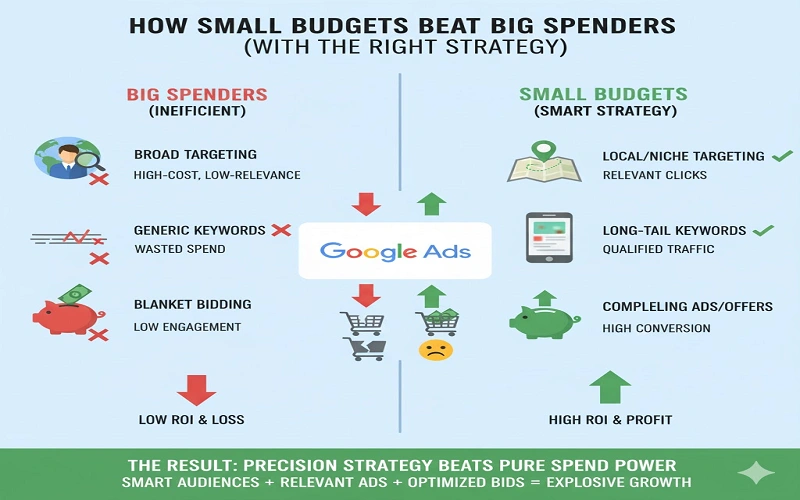A local service business owner told me last month that they couldn’t compete in Google Ads because competitors were spending 10x their budget. When I showed them their Auction Insights report, reality looked different. Yes, competitors had bigger budgets, but they were wasting most of it—terrible Quality Scores, irrelevant keywords, generic ad copy, and poor landing pages. Within eight weeks of strategic optimization, my client was outranking them consistently despite spending 70% less.
This happens more often than people realize. Budget size doesn’t determine campaign success—strategic execution does. Smaller advertisers with expert management routinely outperform larger competitors who throw money at poorly optimized campaigns.
The Competition Reality Nobody Explains
Here’s what most businesses don’t understand about competitive markets: you don’t need the biggest budget to win, you need the smartest strategy. Research shows average Google Ads cost per click in India ranges from ₹5-50, with highly competitive industries like finance, real estate, and legal services exceeding ₹100 per click. But paying more doesn’t automatically deliver better results.
Quality Score creates the great equalizer. This 1-10 rating from Google affects both your cost per click and ad position. Advertisers with scores of 8-10 pay 30-50% less per click than competitors scoring 4-5 while simultaneously achieving better placement. A smaller budget with superior Quality Score beats a larger budget with poor optimization every single time.
The typical small business advertising budget in India runs ₹5,000-50,000 monthly depending on goals and industry competitiveness. That might seem tiny compared to large corporations spending lakhs daily, but strategic optimization transforms limited budgets into competitive weapons. The key is concentrating spending where it delivers maximum impact rather than spreading it thin across mediocre campaigns.
Industry benchmarks reveal the performance landscape. Average conversion rates sit around 6.96% across industries, but this masks enormous variation—some sectors convert at 12%+ while others struggle at 2-3%. Your results depend on dozens of factors beyond just budget size: targeting precision, ad relevance, landing page quality, offer strength, and competitive positioning.
The auction system itself favors smart optimization over raw spending power. Google ranks ads based on Ad Rank—a combination of bid amount and Quality Score. An advertiser with a ₹10 bid and Quality Score of 9 (Ad Rank 90) outranks a competitor with ₹30 bid and Quality Score of 2 (Ad Rank 60) while paying less. Strategic execution multiplies budget effectiveness exponentially.
Most businesses competing on budget alone waste 40-60% of their spending through fundamental inefficiencies—wrong keywords, poor ad copy, irrelevant traffic, weak landing pages. That waste creates opportunities for strategic smaller advertisers to capture valuable clicks competitors are neglecting or mismanaging.
The Strategic Advantages Small Budgets Actually Have
This is where professional adwords management services transform competitive disadvantages into strategic advantages. Smaller budgets force precision that larger advertisers never develop because they can afford to waste money. When every rupee counts, optimization becomes mandatory rather than optional.
Long-tail keyword targeting represents the first major advantage. While big spenders compete for expensive generic terms like “insurance” (₹100+ per click), smaller budgets target specific long-tail phrases like “term life insurance quotes for 35-year-old non-smoker” that convert better at lower costs. These high-intent searches deliver superior conversion rates because searchers already know exactly what they want.
Geographic concentration provides another edge. Large national campaigns spread budgets across entire countries, but local businesses targeting specific cities or neighborhoods achieve higher relevance and lower competition. Someone searching “best dentist Koramangala Bangalore” shows higher intent than generic “dentist” searches, and local targeting eliminates competition from businesses outside your service area.
Tighter audience segmentation focuses limited budgets on most valuable prospects. While big spenders use broad targeting trying to reach everyone, strategic campaigns concentrate on high-intent audiences—people who visited your site previously, users actively researching your product category, demographics matching your best customers. This precision targeting dramatically improves conversion efficiency despite smaller reach.
The agility advantage shouldn’t be underestimated either. Small campaigns adjust quickly to what’s working, pausing underperformers and doubling down on winners within days. Large campaigns with multiple stakeholders and bureaucratic approval processes take weeks making the same changes, allowing nimble competitors to capitalize on opportunities faster.
Superior ad copy and landing page experiences beat budget size consistently. When competitors run generic ads leading to cluttered landing pages, strategic advertisers with compelling value propositions and conversion-optimized experiences capture more traffic at lower costs. Quality trumps quantity every time in advertising effectiveness.
The Competitive Intelligence That Changes Everything
Understanding what competitors actually do—not just guessing—transforms strategic planning completely. Google Ads Auction Insights shows exactly who competes for your keywords, how often you overlap in auctions, their impression share, average position, and overlap rate. This intelligence reveals whether competitors dominate through superior optimization or just bigger budgets.
Professional competitive analysis uncovers specific weaknesses exploitable with strategic campaigns. Tools like SEMrush, SpyFu, and specialized PPC analysis platforms reveal competitors’ exact keywords, ad copy, estimated budgets, landing pages, and performance patterns. When you know competitors are bidding on irrelevant keywords or using weak ad copy, you can outmaneuver them through precision rather than spending.
Keyword gap analysis identifies opportunities competitors miss entirely. These untapped search terms with decent volume but low competition represent gold for smaller budgets—areas where you can dominate without fighting entrenched competition. While big spenders fight over saturated keywords, strategic advertisers capture valuable traffic competitors don’t even know exists.
The Google Ads Transparency Center provides another intelligence source most businesses ignore. This free tool shows all ads any advertiser is currently running, including copy, formats, targeting regions, and campaign durations. Seeing exactly what messaging competitors use reveals positioning gaps you can exploit with differentiated value propositions.
YouTube targeting presents particularly interesting competitive opportunities. Running ads on competitor review videos or industry comparison content places your messaging directly in front of in-market prospects already researching solutions. This piggybacking strategy leverages competitors’ marketing investments to reach ready-to-buy audiences at fraction the cost.
Auction insights combined with performance data reveals the complete competitive picture. If competitors have high impression share but you’re converting better, you’re winning on efficiency even with lower visibility. If they dominate certain keywords, identify related terms where competition is lighter but intent remains strong. Strategic positioning around competitor strengths creates profitable opportunities.
Why Professional Management Multiplies Small Budget Effectiveness
Professional google ads agency amplify limited budgets through expertise large competitors rarely possess despite bigger spending. Agencies working across dozens of accounts daily recognize optimization opportunities instantly that individual businesses miss entirely. They implement proven competitive strategies rather than guessing what might work.
Quality Score optimization happens systematically rather than haphazardly. Professionals write ad copy specifically designed for relevance and click-through improvement. They structure accounts around tightly-themed ad groups matching keywords precisely. They optimize landing pages for speed, mobile performance, clear value propositions, and conversion focus. These optimizations compound into 30-50% cost reductions plus better placement.
The negative keyword development prevents small budget waste that larger advertisers can absorb. Comprehensive blocking of irrelevant searches ensures every rupee reaches genuinely potential customers rather than random browsers. For ₹20,000 monthly budgets, preventing 25% waste saves ₹5,000—enough to fund an entire additional campaign.
Bid strategy optimization ensures limited budgets compete where winning is possible. Smart Bidding with Target CPA focuses spending on auctions likely to convert profitably. Bid adjustments favor high-performing devices, locations, times, and audiences while reducing spend on underperformers. This strategic allocation multiplies budget effectiveness exponentially.
Competitor intelligence gathering through professional tools reveals exactly where to focus limited resources for maximum impact. Instead of competing head-on with category leaders on expensive keywords, strategies target adjacent opportunities competitors overlook. This indirect competition approach captures valuable traffic without expensive bidding wars.
The continuous testing culture maintains competitive edges once established. While competitors remain static, professional management tests new ad variations weekly, landing page optimizations monthly, and strategic positioning quarterly. This constant improvement compounds advantages over time until small budget campaigns outperform larger competitors consistently.
The Budget Efficiency That Beats Raw Spending
Strategic campaign management transforms cost structures dramatically.
- When Quality Scores improve from 5 to 8, cost per click drops 35-40%.
- When conversion rates double through landing page optimization, every rupee generates 2x the business value.
- When negative keywords eliminate 30% waste, effective budget increases by 43% without spending more. These efficiency gains compound into 3-5x performance improvements.
Consider the math. A ₹30,000 monthly budget with 4% waste (₹1,200 lost), 5% conversion rate, and ₹300 average CPC generates roughly 16 conversions. That same budget optimized with 0% waste, 10% conversion rate, and ₹180 CPC (40% reduction from Quality Score improvement) generates approximately 55 conversions—342% better results from identical spending.
The alternative is competing on budget alone against larger advertisers who can simply outspend smaller competitors. Without strategic optimization, limited budgets get crushed by raw spending power. Smart businesses recognize that advertising effectiveness comes from expertise applied to execution, not just money thrown at problems.
Cross-channel coordination extends competitive advantages further. While focusing primarily on Google Ads optimization, professional management integrates search campaigns with display remarketing, YouTube awareness building, and social media nurturing. These coordinated efforts create multiple touchpoints reaching prospects throughout their buying journey without duplicating spend.
The staying-current advantage prevents strategic decay over time. Google introduces new features, targeting options, bidding strategies, and automation tools constantly. Agencies test innovations immediately, determining what works before competitors even hear about updates. This continuous adaptation maintains competitive edges despite smaller budgets.
The Strategic Investment That Levels Competition
Working with professional services eliminates the expertise gap that typically favors larger advertisers with dedicated internal teams. You get immediate access to optimization knowledge that took years developing across hundreds of campaigns. May benefit from competitive intelligence tools and analysis frameworks most small businesses can’t afford independently. You receive continuous strategic refinement adapting to market changes and competitive moves.
The financial case is straightforward. If professional management costs 15% of ad spend (₹4,500 on ₹30,000 budget) but improves results 300% through optimization, the ₹4,500 investment generates ₹60,000 in additional value. The service pays for itself 13x over before counting time savings and opportunity cost recapture.
The alternative is competing blindly against strategic competitors who optimize relentlessly while you guess what might work. Smart businesses recognize that budget size matters far less than how effectively that budget gets deployed. Professional expertise transforms competitive disadvantages into strategic advantages through precision execution that larger competitors with sloppy optimization simply can’t match.
Small budgets don’t determine campaign failure—poor execution does. With strategic optimization, expert management, and competitive intelligence driving decisions, limited budgets consistently outperform larger competitors who waste money through fundamental inefficiencies. That’s not theory—it’s reality playing out daily in competitive markets where smart beats big every single time.




